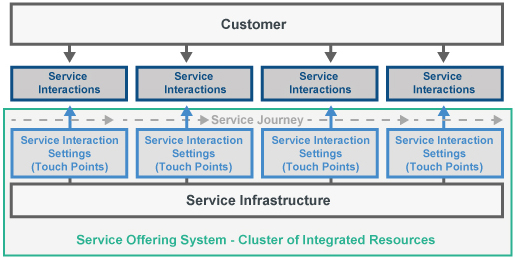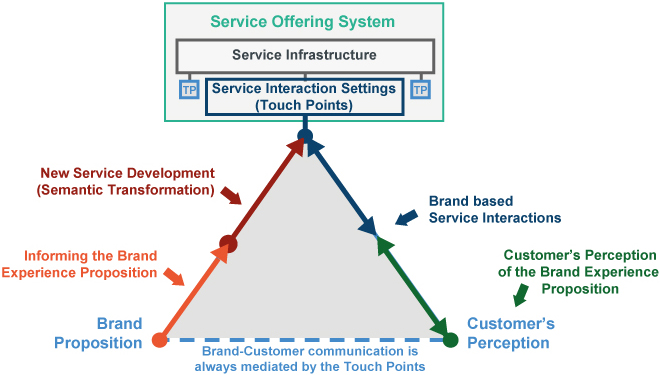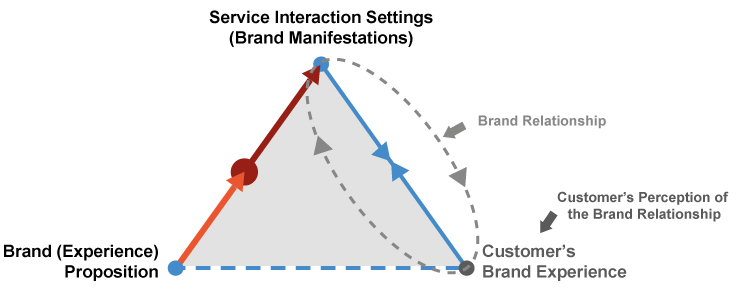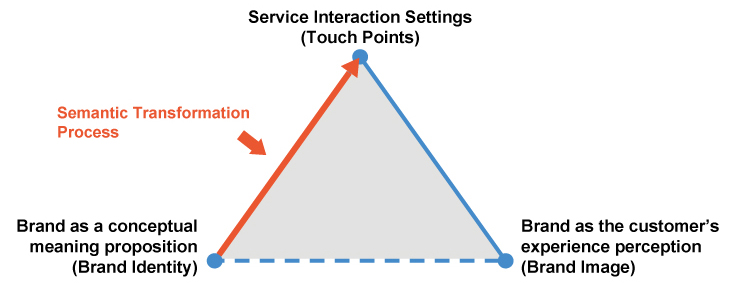Designing for Brand Experience – Theoretical Background
This section describes the theoretical groundings for the research. The first subsection proposes that the experience proposition the organization is trying to deliver to the customers is actually the Brand Experience. Following, Designing for Brand Experience is presented as an approach that enables the translation of Brand Strategy into Customer Experiences through a Semantic Transformation process, operationalizing Service Branding. Finally, in the last subsection, it is suggested that the best way to communicate the Brand Experience Proposition is through the use of a relationship metaphor.
This theoretical background grounds the experimental side of the research, which is discussed in the ‘Brandslation and Brand Experience Manual’ section. Brandslation is then proposed as a framework that facilitates the translation of the brand identity, as seen by the organization, into a service design friendly Brand Experience Proposition; and the Brand Experience Manual is presented as the outcome from the Brandslation process, systematizing the knowledge developed into the form of a communicable tool, which may be used by the New Service Development teams to design Brand based Service Interactions.
Why is the Brand the Experience?
Definitions of brand are plentiful, yet, one common characteristic unite these different descriptions; brands are seen as something that exists in the interactions between the customers and the organizations (De Chernatony and Riley, 1998). Brands started as markers, names that helped to differentiate commodities from different producers. In its more than 100 year history brands have evolved; now they are understood as the meaning proposition the customer’s are actually acquiring (Klein, 1999), where that brand management became synonymous with meaning management (Fournier et al., 2008).
Yet, a brand is only as valuable as it is perceived to be. From the customer’s perspective, the brand image is a network of meaning associated to the brand name that helps to differentiate the brand from competitors’, and influence customer’s perception; it is this capacity of influencing the customer’s perception that makes the brand so valuable (Aaker, 1991). From the company perspective, the brand is the meaning proposition, a concept, which must be materialized to become an active partner in a relationship with the customers (Fournier, 1998).
In that sense, brands sit in the intersections of two opposing, but yet complementary perspectives. On one hand, the brand is a storehouse for the meanings associated to the brand name by the customers; on the other hand, the brand is a powerhouse, the meaning proposition that is offered to the market through brand manifestations (Sherry, 2005). If this meaning proposed by the organization is to be perceived by the customer, it must be materialized in some sort of manifestation that supports the interaction between the customers and the brand.
From the customer’s point of view, the brand image is the outcome of his perception from the interactions with the brand’s manifestations; by experiencing the brand, the customers associate a set of meanings to the brand name; as these experiences add up, the meaning network is updated, actualizing the brand image. Since the brand’s value lies in its capacity to influence the customer’s perception, it is these meaning networks, which are informed by the interactions with the brand’s manifestations that create value for the brand.
In that sense, the brand resides in the customer’s minds as the result of the relationship built through the interactions over the years. On one side, the brand makes a value proposition, which is materialized as a brand manifestation; on the other side, the customers experience the brand’s value propositions by interacting with the brand’s manifestations (touch points). If the interactions are successful, and further exchange is beneficial for both parts, the relationship will develop, and the brand will thrive; otherwise, the brand will perish for lack of sponsors.
The brand is thus the result of the continuous negotiations between the customers’ perceptions and a value proposition materialized through the customer’s interactions with the brand’s manifestations. If the organization decides to ignore the existing relationship and disregard the current value proposition, it risks destroying the meaning associations that makes their brands valuable. As such, in designing new offerings, the organization must aim at delivering a consistent experience, and in that sense, the brand is the experience the organization is trying to deliver.
It is worth noting that the experience the brand is proposing does not necessarily means an extraordinary one. Contrary to the view expressed in The Experience Economy (Pine and Gilmore, 1998), in which the focus is upon rich experiential offerings, our view is that a brand experience is meaningful as long as it communicates the intended brand meaning. Although the meaning proposition must be valuable and relevant to the customers, the concept of experiences can also be understood in an ordinary sense, experiences as the customer’s perception from the service interaction’s qualities, and not as some hedonic offering; an extraordinary ordinary experience.
As it has been mentioned earlier, the Brand Experience Proposition is communicated, and experience by the customers through service interactions. At some stage in the development process, the interactions have to be designed to align with the Brand Experience Proposition. In the next subsection, the process of translating the brand strategy into customer’s experience will be explained through the concept of Designing for Brand Experiences, which is proposed as a way to operationalize Service Branding.
Designing for Brand Experience
Definitions for the term ‘branding’ are not as abundant as for the term ‘brand’; most of the time, branding is understood in the grammatical sense as something you do to the brand, suggesting a double interpretation of the concept. On one hand, branding can be related to the brand’s role as a meaning powerhouse; in that sense, branding refers to defining what the brand proposition is (Aaker and Joachimsthaler, 2000). On the other hand, a brand is also a storehouse of meanings; as the brand must be manifested to interact with the customers and communicate its meanings, branding therefore also refers to the process of delivering the brand proposition to the customer.
As such, the two meanings of the branding concept are strongly interrelated. To deliver a brand-based experience to the customer, branding needs to know what the experience proposition is; correspondingly, to interact with the customer, the brand must be manifested. The Brandslation process, which is presented in the empirical section of this text, focuses on both aspects; first, it helps the organization express their Brand Proposition in an experiential way; second, it communicates this Brand Experience Proposition to the New Service Development (NSD) teams responsible for designing (for) the services interactions. Additionally, it also creates a “target” which can be used as a benchmark for the new services.
Semantic transformation is “the act of encoding intentional meanings into a product design elements” (Karjalainen, 2004, p.235). It takes place at the early stages of the NSD process when the service concept is defined, and the outlines for service system and process are designed. Similarly to Peirce’s approach to semiotics, Semantic Transformation suggests that, as conceptual meaning propositions, brands can be translated and embedded in design characteristics that will communicate the brand to the customer. In other words, at this stage, the brand proposition must be materialized into service interaction settings, so when the customers interact with these manifestations, they can perceive the brand proposition (Image 1).
Image 1 – Semantic Transformation Process
The use of Peirce’s semiotic perspective recognizes the role of the customer as an interpreter of the experience. In that sense, experience is understood as a phenomenological concept, the customer’s perception of the service interaction, and as such, they can’t be designed, but only designed for. Similarly, services emerge in the interaction between two parts in the value co-creation process and consequently, an organization does not design a service, but the setting that will allow the service to emerge (Edvardsson and Olsson, 1996). As Shostack (1982) compares, a service is much like potential energy; a stored capacity, which when released in the form of kinetic energy, is capable of performing a deed.
As kinetic energy, a service emerges from the interactions of the resource constellations that each participating side brings in. On the company side, the organization integrates a set of resources and makes them available to the customers as service offering; on the other side, the customers bring their own resources to the interaction. By making the offerings manifested through service settings (Image 2), the organization can interact with the customer and co-create value; as the customers need for the resources offered by the organization, they engage in value-in-exchange (Vargo, 2008; Vargo et al., 2010).
Notwithstanding, value-in-use is phenomenologically determined by the customers (Vargo and Lusch, 2004), and as such, the exchange value is dependent of the customer’s perception of the value co-created by the service interaction (Sandström et al., 2008). Also, since service is defined as “the application of competences (knowledge and skills) by one entity for the benefit of another” (Vargo et al., 2008, p.145), a service may result from interactions with services or goods, and as such, service is a superordinate term to goods and services (Brodie, et al., 2009).
It can thus be suggested that, in trying to manage the customer’s experience, the organization should focus in designing the setting that will support the service interactions, the service prerequisites (Edvardsson and Olsson, 1996). Yet, services are complex systems formed by the integration of multiple resources; designing the service offering system (Image 2) as an amalgamation of independent parts might result in faulty interactions, and a holistic approach that considers all the integrated resources must be taken (Patrício et al. 2011)

Image 2 – The service offering is grounded in a cluster of integrated resources, which include the service infrastructure supporting the service settings, and the service settings themselves.
As suggested previously, the experience the organization is actually trying to deliver is the brand, a Brand-based Customer Experience; thus, to enable the Brand Experience Proposition to become alive, the NSD teams must embed the service offering system with brand characteristics. This doesn’t mean simply inserting visual brand evidences on the service interactions, but delivering the Brand Experience Proposition through the interactive qualities of the service offering.
In that sense, not only the touch points must be grounded on the Brand Experience Proposition, but also the service offering itself, the value proposition the organization makes to the customer, must reflect the Brand Experience Proposition. Although the customer’s experience is the result of the sum of the interactions with the touch points, designing the service offering system as a patchwork of individual interactions will lead to broken experiences, which will express unintended meanings.
Designing for Brand Experience is thus proposed as a holistic approach to the design of the service offering system, in order to enable the Brand Experience Proposition to become alive through the service interactions. Although seeing services through an integrative perspective is a common topic in the service design discourse, current literature (except for Patrício et al., 2008, 2011) does not explore the integration of the different service systems levels when designing for services. By building on the concept of Semantic Transformation, it is suggested that by properly informing the NSD teams what experience they should design for will enable the development of service offering systems that support Brand based Service Interactions (Image 3).

Image 3 – Informing the NSD teams what the Brand Experience Proposition is facilitates the Semantic Transformation process, and consequently, the development of Service Interaction Settings that delivers Brand based Service Interactions.
In the following subsection the chosen representation of the Brand Experience Proposition is presented.
The Relationship Metaphor
Customer’s relationship with brands emerges in the continuous interaction with the brand’s manifestations. To influence the customer’s perception, the organizations embeds brand meanings in the service interactions; as the relationship develops, and the brand consistently delivers on the experience proposition, the customers start to accept the brand as an active partner in the relationship (Fournier, 1998). Since customers have very little difficulty in anthropomorphizing a brand, they develop the perception of the brand as a character with whom they interact (Aaker, 1997).
In that sense, it can be suggested that the customer develops a relationship with the brand personality; yet, Aaker’s (1997) definition of the concept as a set of human characteristics associated to the brand is limiting. As it became evident in the empirical research, the brand personality is seen as much more than just a set of traits, it is also seen in relation to the customers, it has demographic characteristics and typical behaviors; a brand character that expresses the relationship the organization wants to create with the customer.
Since the brand relationship is, from the customer’s perspective, the outcome of the continuous interactions with the brand’s manifestations (Image 4), it is suggested that, in Designing for Brand Experiences, the organization is in fact trying to ‘design’ the customer’s perception of the brand relationship. By designing service interaction settings that delivers the Brand Experience Proposition, the organization strengthens the relationship with the customers. It also must be noticed that the focus should not be the service interaction settings alone, but the whole service offering system (Image 2).

Image 4 – The Brand Experience is the customer’s perception from the brand relationship, which emerges in the customer’s continuous interactions with the brand’s manifestations.
As such, it is proposed that the customer’s perceptions of the brand relationship and of the brand experience are basically the same. The organization can thus use the metaphor of the relationship it wants to develop with the customer as a way to express the Brand Experience Proposition. As the organization is trying to communicate the experience proposition though the service interactions, in designing the service offering system to enable the desired relationship to emerge, the NSD teams are in fact designing for the brand experience.
The relationship metaphor is one of the outcomes from the empirical research; through multiple rounds of explorative iterations in trying to communicate the desired experience, finding the right words to describe it became a problem. In that context, a personality analogy (Clatworthy, 2013) was explored, but it was found to be limited solution, as it does not convey the necessary depth to communicate the nuances of the desired experience. As the explorative iteration developed, the relationship metaphor emerged as a clearer way to express what is the experience the organizations wants the customer to have, and what are the actions it should engage to achieve so.
In the empirical section of this text, the Brandslation process is presented as a framework that helps the organizations to translate their brand identity into an service design friendly relationship metaphor; as a service design process itself, the Brandslation process is co-creative by nature, and explores the views of multiple stakeholders, developing a Brand Experience Proposition that is not only grounded on the organization understanding of the brand, but also including the customers and employees point of view. As the outcome of the process, the Brand Experience Manual is proposed as a tool that systematizes and communicates the Brand Experience Proposition to the service design teams.
References:
- Aaker, D. (1991). Managing Brand Equity. Free Press: New York
- Aaker, D., Joachimsthaler, E. (2000). Brand Leadership, London: Free Press
- Aaker J. L.; (1997). Dimensions of Brand Personality. Journal of Marketing Research. 34 (3), p. 347-356
- Brodie, R. J., Whittome, J. R. M., & Brush, G. J. (2009). Investigating the Service Brand: A Customer Value Perspective. Journal of Business Research, 62(3), 345–355.
- Clatworthy, S. (2013). Design support at the front end of the New Service Development (NSD) process: The role of touch-points and service personality in supporting team work and innovation processes. Oslo, Norway: Arkitekthøgskolen i Oslo. PhD thesis.
- De Chernatony, L., & Riley, F. D. O. (1998). Defining a “Brand”: Beyond the Literature With Experts` Interpretation. Journal of Marketing Management, 14(5), 417-443
- Edvardsson, B., & Olsson, J. (1996). Key concepts for new service development. Service Industries Journal, 16(2), 140-164.
- Fournier, S., (1998). Consumers and Their Brands: Developing Relationship Theory in Consumer Research. Journal of Consumer Research, 24(4), p. 343-353
- Fournier, S., Solomon, M. R., Englis, B. G. When Brands Resonate, in:Handbook on Brand and Experience Management, Schmitt, B. H., Rogers, D. L. (editors). Edward Elgar: Northampton, Massachusetts, 2008
- Karjalainen, T. M., (2004). Semantic Transformation in Design: Communicating strategic brand identity through product design references. Helsinki: University of Art and Design of Helsinki
- Klein, N. (1999). No logo: taking on the brand bullies. New York, Picador.
- Patrício, L., Fisk, R. P., & Cunha, J. F. (2008). Designing multi-interface service experiences: The service experience blueprint. Journal of Service Research, 10(4), 318-334.
- Patrício, L., Fisk, R. P., Cunha, J. F., & Constantine, L. (2011). Multilevel service design: from customer value constellation to service experience blueprinting. Journal of Service Research
- Pine, B. J., & Gilmore, J. H. (1998). Welcome to the experience economy. Harvard business review, 76, 97-105.
- Sandström, S., Edvardsson, B., Kristensson, P., & Magnusson, P. (2008). Value in use through service experience. Managing Service Quality: An International Journal, 18(2), p. 112-126.
- Sherry, J. F., Jr., (2005). Brand Meaning in Kellogg on Branding, Eds. Calkins, T., Tybout, A., Hoboken, New Jersey: John Wiley & Sons
- Shostack, G. L. (1982). How to design a service. European Journal of Marketing, 16(1), 49-63.
- Vargo, S. L. (2008). Customer integration and value creation Paradigmatic Traps and Perspectives. Journal of service research, 11(2), 211-215.
- Vargo, S. L., & Lusch, R. F. (2004). Evolving to a new dominant logic for marketing. Journal of marketing, 68(1), 1-17.
- Vargo, S. L., Lusch, R. F., Akaka, M. A., & He, Y. (2010). The service-dominant logic of marketing: A review and assessment. Review of marketing research, 6(2), 125-167.
- Vargo, S. L., Maglio, P. P., & Akaka, M. A. (2008). On value and value co-creation: A service systems and service logic perspective. European management journal, 26(3), 145-152.
Notes:
Brandslation is a registered trademark of the Oslo School of Architecture and Design
For more on the topic, go to http://designresearch.no/people/mauricy-filho
Special thanks to Simon Clatworthy, Johan Blomkvist and Paulo Peres for the help reviewing the text




